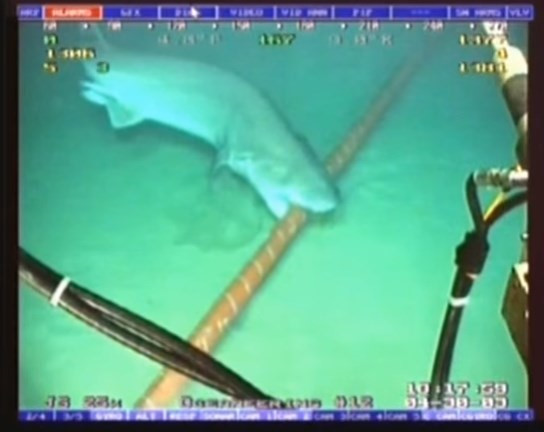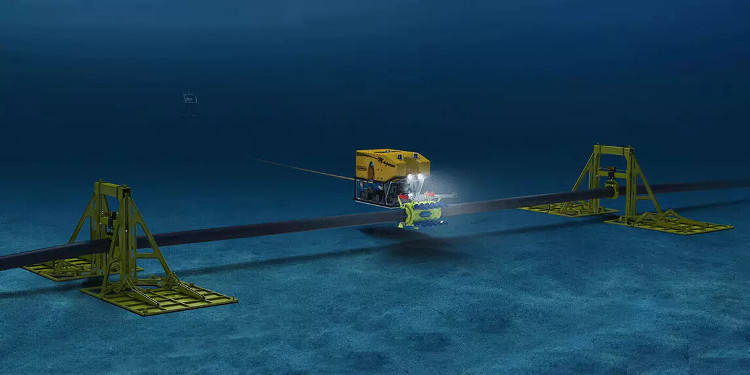10 facts about transatlantic network cables
Underground cables only have a lifespan of 25 years and are very vulnerable. However, with a transmission rate of 99.7% of the speed of light, they are still considered the lifeblood of the world.
1. Installation takes a lot of time and money
Up to 99% of international data transmitted by wires at the bottom of the ocean is called an underground communication cable. Their total length can reach hundreds of thousands of miles and bury thousands of meters in the seabed.
The cables are installed by special vessels called cable layers. Not only are strings removed with clips connected to them, cables must often be run on the flat surface of the ocean floor and be careful to avoid coral reefs, sunken wrecks and other obstacles.
The shallow water cable is buried in the ocean floor using a high-pressure water jet. Although the price for each mile of cable varies depending on the total length and destination, the installation of cables across the sea always costs hundreds of millions of dollars.
2. Sharks are trying to eat the network cable
There is an argument about why shark markings appear on underground cables. Many theories suggest that they react with electromagnetic fields on cables. Or simply because they are curious about these wired entities.

Sharks are lifelong enemies of undersea network cables.(Photo: YouTube).
The problem is that sharks are still biting into cables every day and sometimes damaging them. To overcome this, similar companies Google is shielding their cables in shark defense devices.
3. Network cables are more vulnerable to underwater than underground
Every few years, some construction workers drive the bulldozers and break the entire Netflix network on the mainland. While the ocean does not have construction equipment, it still has its own threats.
Ignoring the element of sharks, the Internet is always at risk of being destroyed by the mooring of ships or destruction by natural disasters. A Toronto-based company has proposed running an Internet cable through the North Pole to connect Tokyo and London.
This in the past was impossible but climate change made ice melt that set the stage for this idea to be implemented. But the cost for it is still really expensive.
4. Connecting the world via a long-established sea cable
Since 1854, the installation of marine cables began with a transatlantic telegraph cable connecting Newfoundland and Ireland. Four years after the first successful transmission was sent and received is still too weak to be used. But in that historical context, the time of science and technology is still underdeveloped, this is worth considering as the milestone of the underground cable industry.

The first communication line was installed 163 years ago.(Photo: Mentalflos).
5. Fatty bait for intelligence agencies
During the Cold War, the Soviet Union often transmitted weak coded messages between its two major naval bases and was directly connected by underground cables in the Soviet territorial waters.
The US submarine tried to find these cables and installed a giant phone cord then returned every month to collect the transmissions it had recorded from the Soviet cable segment.
This activity is called IVY BELLS. Today, exploiting undersea communication cables is the standard activity of intelligence agencies.
6. National governments turn to underground cable to avoid spying
A major advantage of the United States is the possession of a team of scientists, engineers and corporations in inventing and building a large part of the global telecommunications infrastructure. The key cable segments of the world tend to cross the borders and territorial waters of the United States. This makes eavesdropping easier than ever.
Therefore, some countries are reconsidering the Internet infrastructure. Brazil, for example, has launched a project to build an underground communication cable to Portugal. Not only did it avoid American territory but it also excluded the list of the country's supply and installation companies from the construction list.
7. Underground cables are faster and cheaper than satellites
Satellite is a future technology, born after optical fiber but it cannot replace this connection. Satellite has a problem with the transmission speed. Sending and receiving signals to and from space takes more time.

The cable repair costs a lot of time and money.(Photo: Mentalflos).
Meanwhile, researchers have developed optical fibers that can transmit information at 99.7% of the speed of light. To find out what the Internet speed will be if there is no undersea cable, visit Antarctica, the only continent that does not have a physical connection to the network.
In this continent, Internet connection is based only on satellites, and bandwidth is high. However, Antarctic research stations are producing more data than they can transmit through space.
8. Just need a diving suit and a cable cutting device to paralyze the global internet
The good news is, it's hard to cut through the undersea communication cable, if only because of thousands of lethal volts are running through each. Bad news is possible,
The good news is that underground cables have thousands of volts of electricity running through each strand and it's difficult to cut this cable. The bad news, however, is that it has been cut. In Egypt in 2013 there was a rare event when men in diving suits were arrested for deliberately cutting underground cables connecting Southeast Asia - Middle East - West - Europe to 12,500 miles long and connect three continents. Internet speed in Egypt has been crippled 60% until the line can be repaired.
9. The underwater network cable is not easy to fix
When an underground cable is damaged, special repair vessels are dispatched to the suspected damaged location. If the cable is in shallow water, the robot will be deployed to search and pull it to the surface.

Cables located deep in the ocean floor require specialized equipment to be able to check for replacement.(Photo: Submarinenews).
If the cable is located in a deep water of about 2,000 m, a dedicated vessel designed to take the cable will lift it to the surface and repair it. To make things easier, this device sometimes cuts broken cables and the repair ship will lift the two heads and connect them on the water.
10. Underground cable has a lifespan of 25 years
As of 2014, there are 285 communication cables at the bottom of the ocean and 22 of them are not yet used. This is called "black cable". Underground cables have a lifespan of 25 years.
However, over the past decade, global data consumption has exploded. In 2013, Internet traffic was 5 gigabytes per capita; This figure is expected to reach 14 gigabytes per capita in 2018.
This increase will obviously cause capacity problems and need to upgrade the cable more often. However, new techniques in phase modulation and terminal improvement (SLTE) have increased capacity in some places up to 8,000%. It helps solve data needs for the whole world.
- How are marine optical cables welded?
- How are APG and AAG cables different?
- Learn about basic WLAN devices
- First transatlantic flight by bio-gas
- Video: 6,400km undersea fiber network connecting the two continents
- Japan has successfully tested fiber optic cable 100 times faster than the current Internet
- Boat made from 3D technology can cross the Atlantic
- Cable 'live'
- Why is wired (Ethernet) better than Wifi?
- How are marine optical cables welded?
- This is what NASA will use to hunt aliens
- Video: The fiber optic network is intertwined on the ocean floor
- A series of fun facts that answer your own eternal questions!
- Basics of network devices
 'Fine laughs' - Scary and painful torture in ancient times
'Fine laughs' - Scary and painful torture in ancient times The sequence of numbers 142857 of the Egyptian pyramids is known as the strangest number in the world - Why?
The sequence of numbers 142857 of the Egyptian pyramids is known as the strangest number in the world - Why? History of the iron
History of the iron What is alum?
What is alum? Tiny creatures mating causes entire village to lose internet connection
Tiny creatures mating causes entire village to lose internet connection  Fiber optic cable laying system in the world's deepest abyss
Fiber optic cable laying system in the world's deepest abyss  Cable cars inherently have the principle of 'extremely safe', why do accidents still occur?
Cable cars inherently have the principle of 'extremely safe', why do accidents still occur?  Paris plans to open its first urban cable car system in 2025
Paris plans to open its first urban cable car system in 2025  Norway's 4km cable disappeared without a trace, is the culprit giant squid?
Norway's 4km cable disappeared without a trace, is the culprit giant squid?  How Google, Facebook put thousands of miles of fiber optic cable under the sea floor?
How Google, Facebook put thousands of miles of fiber optic cable under the sea floor? 